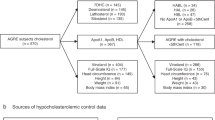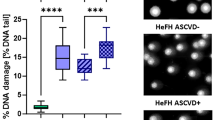Abstract
Type III hyperlipoproteinemia (HLP) is mainly found in homozygous apolipoprotein (APO) E2 (R158C) carriers. Genetic factors contributing to the expression of type III HLP were investigated in 113 hyper- and 52 normolipidemic E2/2 subjects, by testing for polymorphisms in APOC3, APOA5, HL (hepatic lipase) and LPL (lipoprotein lipase) genes. In addition, 188 normolipidemic Dutch control panels (NDCP) and 141 hypertriglyceridemic (HTG) patients were genotyped as well. No associations were found for four HL gene polymorphisms and two LPL gene polymorphisms and type III HLP. The frequency of the rare allele of APOC3 3238 G>C and APOA5 −1131 T>C (in linkage disequilibrium) was significantly higher in type III HLP patients when compared with normolipidemic E2/2 subjects, 15.6 vs 6.9% and 15.1 vs 5.8%, respectively, (P<0.05). Furthermore, the frequencies of the APOA5 c.56 G>C polymorphism and LPL c.27 G>A mutation were higher in type III HLP patients, though not significant. Some 58% of the type III HLP patients carried either the APOA5 −1131 T>C, c.56 G>C and/or LPL c.27 G>A mutation as compared to 27% of the normolipidemic APOE2/2 subjects (odds ratio 3.7, 95% confidence interval=1.8–7.5, P<0.0001). The HTG patients showed similar allele frequencies of the APOA5, APOC3 and LPL polymorphisms, whereas the NDCP showed similar allele frequencies as the normolipidemic APOE2/2. Patients with the APOC3 3238 G>C/APOA5 −1131 T>C polymorphism showed a more severe hyperlipidemia than patients without this polymorphism. Polymorphisms in lipolysis genes associate with the expression and severity of type III HLP in APOE2/2.
Similar content being viewed by others
Log in or create a free account to read this content
Gain free access to this article, as well as selected content from this journal and more on nature.com
or
References
Morganroth J, Levy RI, Fredrickson DS : The biochemical, clinical, and genetic features of type III hyperlipoproteinemia. Ann Intern Med 1975; 82: 158–174.
Brewer Jr HB, Zech LA, Gregg RE, Schwartz D, Schaefer EJ : NIH Conference. Type III hyperlipoproteinemia: diagnosis, molecular defects, pathology, and treatment. Ann Intern Med 1983; 98: 623–640.
Smelt AH, de Beer F : Apolipoprotein E and familial dysbetalipoproteinemia: clinical, biochemical, and genetic aspects. Semin Vasc Med 2004; 4: 249–257.
Mahley RW, Rall Jr SC : Apolipoprotein E: far more than a lipid transport protein. Annu Rev Genomics Hum Genet 2000; 1: 507–537.
Utermann G : Apolipoprotein E polymorphism in health and disease. Am Heart J 1987; 113: 433–440.
de Beer F, Stalenhoef AF, Hoogerbrugge N et al: Expression of type III hyperlipoproteinemia in apolipoprotein E2 (Arg158 → Cys) homozygotes is associated with hyperinsulinemia. Arterioscler Thromb Vasc Biol 2002; 22: 294–299.
Utermann G, Hees M, Steinmetz A : Polymorphism of apolipoprotein E and occurrence of dysbetalipoproteinaemia in man. Nature 1977; 269: 604–607.
Zhao SP, Smelt AH, Van den Maagdenberg AM et al: Plasma lipoprotein profiles of normocholesterolemic and hypercholesterolemic homozygotes for apolipoprotein E2 (Arg158 → Cys) compared. Clin Chem 1994; 40: 1559–1566.
Mahley RW, Huang Y, Rall Jr SC : Pathogenesis of type III hyperlipoproteinemia (dysbetalipoproteinemia). Questions, quandaries, and paradoxes. J Lipid Res 1999; 40: 1933–1949.
Olefsky JM, Farquhar JW, Reaven GM : Reappraisal of the role of insulin in hypertriglyceridemia. Am J Med 1974; 57: 551–560.
Zammit VA, Waterman IJ, Topping D, McKay G : Insulin stimulation of hepatic triacylglycerol secretion and the etiology of insulin resistance. J Nutr 2001; 131: 2074–2077.
Sijbrands EJ, Hoffer MJ, Meinders AE et al: Severe hyperlipidemia in apolipoprotein E2 homozygotes due to a combined effect of hyperinsulinemia and an SstI polymorphism. Arterioscler Thromb Vasc Biol 1999; 19: 2722–2729.
Zhang H, Reymer PW, Liu MS et al: Patients with apoE3 deficiency (E2/2, E3/2, and E4/2) who manifest with hyperlipidemia have increased frequency of an Asn 291 → Ser mutation in the human LPL gene. Arterioscler Thromb Vasc Biol 1995; 15: 1695–1703.
Schaefer JR, Sattler AM, Hackler B et al: Hyperlipidemia in patients with apolipoprotein E2/2 phenotype: apolipoprotein A5 S19W mutation as a cofactor. Clin Chem 2004; 50: 2214.
Evans D, Seedorf U, Beil FU : Polymorphisms in the apolipoprotein A5 (APOA5) gene and type III hyperlipidemia. Clin Genet 2005; 68: 369–372.
Evans D, Beil FU : The D9N, N291S and S447X variants in the lipoprotein lipase (LPL) gene are not associated with type III hyperlipidemia. BMC Med Genet 2007; 8: 56.
Talmud PJ, Humphries SE : Genetic polymorphisms, lipoproteins and coronary artery disease risk. Curr Opin Lipidol 2001; 12: 405–409.
Merkel M, Eckel RH, Goldberg IJ : Lipoprotein lipase: genetics, lipid uptake, and regulation. J Lipid Res 2002; 43: 1997–2006.
Jansen H, Verhoeven AJ, Sijbrands EJ : Hepatic lipase: a pro- or anti-atherogenic protein? J Lipid Res 2002; 43: 1352–1362.
Zambon A, Deeb SS, Pauletto P, Crepaldi G, Brunzell JD : Hepatic lipase: a marker for cardiovascular disease risk and response to therapy. Curr Opin Lipidol 2003; 14: 179–189.
Pennacchio LA, Olivier M, Hubacek JA et al: An apolipoprotein influencing triglycerides in humans and mice revealed by comparative sequencing. Science 2001; 294: 169–173.
O'Brien PJ, Alborn WE, Sloan JH et al: The novel apolipoprotein A5 is present in human serum, is associated with VLDL, HDL, and chylomicrons, and circulates at very low concentrations compared with other apolipoproteins. Clin Chem 2005; 51: 351–359.
Henneman P, Schaap FG, Havekes LM et al: Plasma apoAV levels are markedly elevated in severe hypertriglyceridemia and positively correlated with the APOA5 S19W polymorphism. Atherosclerosis 2007; 193: 129–134.
Henneman P, Schaap FG, Rensen PC, van Dijk KW, Smelt AH : Estrogen induced hypertriglyceridemia in an apolipoprotein AV deficient patient. J Intern Med 2008; 263: 107–108.
Assman G, Schulte H : Lipid Metabolism Disorders and Coronary Heart Disease. Results and Conclusions of the Prospective Cardiovascular Munster (PROCAM) Study. 2nd Eds. München: MMV Medizin Verlag. 1993, pp 19–67.
Smit M, De Knijff P, Rosseneu M et al: Apolipoprotein E polymorphism in The Netherlands and its effect on plasma lipid and apolipoprotein levels. Hum Genet 1988; 80: 287–292.
Hofman A, Grobbee DE, de Jong PT, van den Ouweland FA : Determinants of disease and disability in the elderly: the Rotterdam Elderly Study. Eur J Epidemiol 1991; 7: 403–422.
Stolk RP, Pols HA, Lamberts SW, de Jong PT, Hofman A, Grobbee DE : Diabetes mellitus, impaired glucose tolerance, and hyperinsulinemia in an elderly population. The Rotterdam Study. Am J Epidemiol 1997; 145: 24–32.
Havekes LM, De Knijff P, Beisiegel U, Havinga J, Smit M, Klasen E : A rapid micromethod for apolipoprotein E phenotyping directly in serum. J Lipid Res 1987; 28: 455–463.
Reymer PW, Groenemeyer BE, van de BR, Kastelein JJ : Apolipoprotein E genotyping on agarose gels. Clin Chem 1995; 41: 1046–1047.
Burstein M, Scholnick HR, Morfin R : Rapid method for the isolation of lipoproteins from human serum by precipitation with polyanions. J Lipid Res 1970; 11: 583–595.
Starr JI, Mako ME, Juhn D, Rubenstein AH : Measurement of serum proinsulin-like material: cross-reactivity of porcine and human proinsulin in the insulin radioimmunoassay. J Lab Clin Med 1978; 91: 683–692.
Miller SA, Dykes DD, Polesky HF : A simple salting out procedure for extracting DNA from human nucleated cells. Nucleic Acids Res 1988; 16: 1215.
Hoffer MJ, Sijbrands EJ, De Man FH, Havekes LM, Smelt AH, Frants RR : Increased risk for endogenous hypertriglyceridaemia is associated with an apolipoprotein C3 haplotype specified by the SstI polymorphism. Eur J Clin Invest 1998; 28: 807–812.
Hoffer MJ, Bredie SJ, Snieder H et al: Gender-related association between the −93T → G/D9N haplotype of the lipoprotein lipase gene and elevated lipid levels in familial combined hyperlipidemia. Atherosclerosis 1998; 138: 91–99.
Jansen H, Verhoeven AJ, Weeks L et al: Common C-to-T substitution at position −480 of the hepatic lipase promoter associated with a lowered lipase activity in coronary artery disease patients. Arterioscler Thromb Vasc Biol 1997; 17: 2837–2842.
Knudsen P, Antikainen M, Ehnholm S et al: A compound heterozygote for hepatic lipase gene mutations Leu334 → Phe and Thr383 → Met: correlation between hepatic lipase activity and phenotypic expression. J Lipid Res 1996; 37: 825–834.
Hegele RA, Tu L, Connelly PW : Human hepatic lipase mutations and polymorphisms. Hum Mutat 1992; 1: 320–324.
Barrett JC, Fry B, Maller J, Daly MJ : Haploview: analysis and visualization of LD and haplotype maps. Bioinformatics 2005; 21: 263–265.
Miller M, Rhyne J, Chen H et al: APOC3 promoter polymorphisms C-482T and T-455C are associated with the metabolic syndrome. Arch Med Res 2007; 38: 444–451.
Talmud PJ, Hawe E, Martin S et al: Relative contribution of variation within the APOC3/A4/A5 gene cluster in determining plasma triglycerides. Hum Mol Genet 2002; 11: 3039–3046.
Dammerman M, Sandkuijl LA, Halaas JL, Chung W, Breslow JL : An apolipoprotein CIII haplotype protective against hypertriglyceridemia is specified by promoter and 3′ untranslated region polymorphisms. Proc Natl Acad Sci USA 1993; 90: 4562–4566.
Lai CQ, Parnell LD, Ordovas JM : The APOA1/C3/A4/A5 gene cluster, lipid metabolism and cardiovascular disease risk. Curr Opin Lipidol 2005; 16: 153–166.
Fisher RM, Benhizia F, Schreiber R et al: Enhanced bridging function and augmented monocyte adhesion by lipoprotein lipase N9: insights into increased risk of coronary artery disease in N9 carriers. Atherosclerosis 2003; 166: 243–251.
Talmud PJ, Stephens JW : Lipoprotein lipase gene variants and the effect of environmental factors on cardiovascular disease risk. Diabetes Obes Metab 2004; 6: 1–7.
Martin-Campos JM, Rico N, Bonet R, Mayoral C, Ordonez-Llanos J, Blanco-Vaca F : Apolipoprotein A5 S19W may play a role in dysbetalipoproteinemia in patients with the Apo E2/E2 genotype. Clin Chem 2006; 52: 1974–1975.
Olivier M, Wang X, Cole R et al: Haplotype analysis of the apolipoprotein gene cluster on human chromosome 11. Genomics 2004; 83: 912–923.
Chen M, Breslow JL, Li W, Leff T : Transcriptional regulation of the apoC-III gene by insulin in diabetic mice: correlation with changes in plasma triglyceride levels. J Lipid Res 1994; 35: 1918–1924.
Altomonte J, Cong L, Harbaran S et al: Foxo1 mediates insulin action on apoC-III and triglyceride metabolism. J Clin Invest 2004; 114: 1493–1503.
Julien P, Vohl MC, Gaudet D et al: Hyperinsulinemia and abdominal obesity affect the expression of hypertriglyceridemia in heterozygous familial lipoprotein lipase deficiency. Diabetes 1997; 46: 2063–2068.
Acknowledgements
This study was supported by the Netherlands Heart Foundation (project no. 94.114) and by the Nutrigenomics Consortium. Sylvia Kamerling, Leonie van Vark and Ton Vroom are thanked for expert technical assistance. The Rotterdam Study is supported by the Netherlands Organisation for Scientific Research and the Municipality of Rotterdam. We thank Jeannette Vergeer, Wilma Luijten and Bianca de Graaf for their help in the laboratory analysis of the Rotterdam Study.
Author information
Authors and Affiliations
Corresponding author
Rights and permissions
About this article
Cite this article
Henneman, P., van der Sman-de Beer, F., Moghaddam, P. et al. The expression of type III hyperlipoproteinemia: involvement of lipolysis genes. Eur J Hum Genet 17, 620–628 (2009). https://doi.org/10.1038/ejhg.2008.202
Received:
Revised:
Accepted:
Published:
Issue date:
DOI: https://doi.org/10.1038/ejhg.2008.202
Keywords
This article is cited by
-
Protective genes and pathways in Alzheimer’s disease: moving towards precision interventions
Molecular Neurodegeneration (2021)
-
Association between apolipoprotein gene polymorphisms and hyperlipidemia: a meta-analysis
BMC Genomic Data (2021)
-
Emerging evidences for the opposite role of apolipoprotein C3 and apolipoprotein A5 in lipid metabolism and coronary artery disease
Lipids in Health and Disease (2019)
-
Influence of APOE-2 genotype on the relation between adiposity and plasma lipid levels in patients with vascular disease
International Journal of Obesity (2015)
-
Hyperlipoproteinemia Type 3: The Forgotten Phenotype
Current Atherosclerosis Reports (2014)



